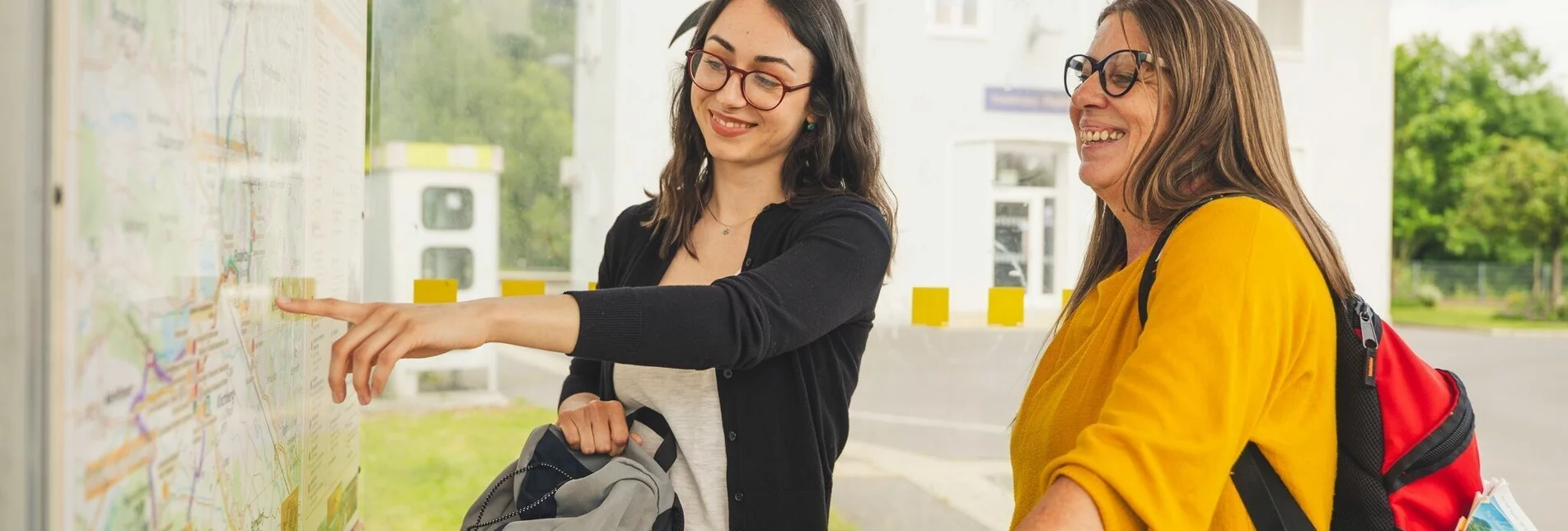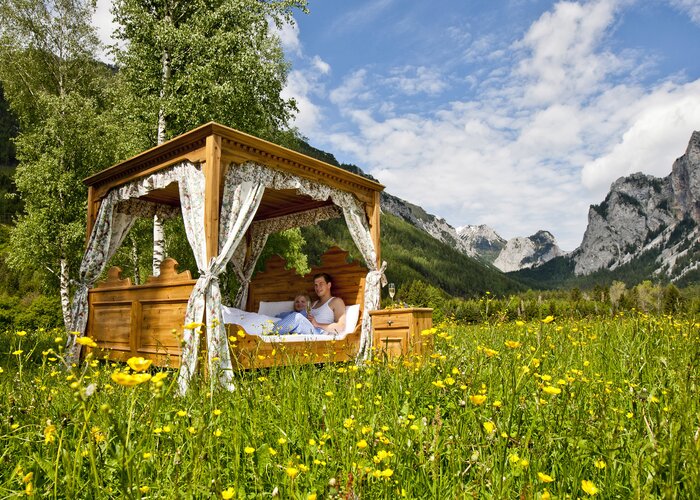

Backbone (Rückgrat) entire length / Feldbach-Klöch
OpenAdditional information
Tourist OfficeThermen- & Vulkanland
Hauptstraße 2a
A-8280 Fürstenfeld
Tel: +43 3382 55 100
info@thermen-vulkanland.at
www.thermen-vulkanland.at
Author
Sabine Hofer
Safety guidelines
- Emergency call fire brigade: 122
- Emergency call police: 133
- Emergency call rescue: 144
- Weather service: www.zamg.ac.at
Directions
Feldbach - Bad Gleichenberg. From head to heart.
We start by walking from Feldbach train station towards the city center, past Tabor and the neighboring parish church with the modern, stand-alone church tower, which was colorfully painted by young people in 1987, to the main square. Here the unique "Steinerner Metzen" may be viewed: it was used to calibrate wooden containers, so called Schaffeln, with which grain was measured. We leave Feldbach via Burgfried and arrive at Mühldorf, from where we ascend the Steinberg, a basalt volcano. Following the backbone made of stone, we hike towards the two Gleichenberg hills, cross a ditch and go up to the Höchkogel in Gossendorf, which offers a stunning view of the gently sculpted landscape. We continue along the ridge and soon arrive at the Gleichenberger Kogel, which is the oldest volcano in the region. What we see today, is only the tip of a huge volcano that once stood in a subtropical sea. As time passed by, it was gradually covered by gravel. At the quarry, which we pass during the ascent, we will find reddish and yellowish shimmering rocks. These are trass rocks, which have been formed by volcanic vapors and gases after the extinction of the volcano. Not far from here, natural mud is mined, which is used in the thermal baths for mud packs.
We circumvent the quarry and hike halfway up the Bschaidkogel, from where we continue to the Mühlsteinbruch. With a bit of luck, we may even find fossils that were washed up here about 10 million years ago by what was then known as the "Mur"! And those who cannot find anything, may still appreciate the view from the lookout post.
Along the forest path we then descend to Bad Gleichenberg, the heart, where natural healing waters for cardiovascular problems spring to the surface. Walking through the center of the village, we will arrive at the well-known Kurpark. The hike leads to the east.
Bad Gleichenberg - St. Anna am Aigen. Across basalt to the vineyards
The second stage of the hike on the Rückgrat leads from Bad Gleichenberg up the fascinating Stradner Kogel and further on to the picturesquely situated St. Anna am Aigen, which we approach from its most scenic side. From the train station we walk only a short distance to the park, where we soon come across the yellow signs for the Rückgrat. We leave Bad Gleichenberg towards the South, cross the main road, ascend the Steinbach and walk further up through the forest to the Stradner Kogel, at 609 m the highest elevation in the Vulkanland. Instead of a panoramic view from the summit, we are surprised by the extensive basalt plateau of Hochstraden. Two million years ago, it was formed by thin lava that flowed out through a vent and spread over the boulders below. There it solidified to become a “basalt cover”. From there we cross the plateau to reach the Waltra rock, where we can see the beginning crumbling rim of this "cover". This mystical location is an ancient worship place, which is also evidenced by artefacts discovered in the area. Take your time to let this place sink in - it's worth it! We continue through the forest to Schemming, where a beautiful view of St. Anna opens up next to the chapel. The trail now descends steeply through beautiful vineyards into the Pleschbach valley, crosses the stream and, on the other side, continues diagonally uphill through the forest. Continuing past the tennis court, we climb steeply up to the town, which rises imposingly on a rock. As a special gem, the well-known wine village is home to the Vinothek Styria, where one may taste wines from all over Styria.
St. Anna am Aigen – Tieschen. Through volcano and wine.
This route starts rather unusual, from the panoramic terrace with a view of Slovenia, down the stairs to the wine store and across the lower terrace to a meadow. Further on we pass below the church, cross the road and go down the steep slope. Over the Pleschbach and further over meadows and fields we finally find a curiosity in Klapping: Carbon dioxide leaking from the ground keeps the "Brodelsulz" bubbling! The gas is created from organic material buried deep under lava and ash, which is slowly transformed into turf and coal. Through the forest and past an accessible mineral water well, we arrive at a well-designed rest area with a fountain in Frutten. For a short distance, the road takes us through the village, before we ascend through the vineyards and a forest section to the Vulkanland lookout post. From here we enjoy an impressive panoramic view of the Styrian peripheral mountains as far as Slovenia and Carinthia. We continue along the "dragons back" to the Rosenberg, which is one of Vulkanland’s most beautiful spots. Soak up the vitality that flows into the surrounding landscape! We gently descend downhill through the vineyards along the edge of a natural amphitheater until we leave the ridge at the road between Hof and Frutten in the direction of Größing. Passing the graceful Größinger Tanner, where we can still see some tumuli from the 1st and 2nd century A.D., and crossing the Drauchenbach stream, we finally arrive in Tieschen.
Characteristics
Best season
The tour in numbers
Map & downloads
More information
Feldbach – Bad Gleichenberg. Vom Kopf zum Herz.Zunächst wandern wir vom Feldbacher Bahnhof stadteinwärts, vorbei am Tabor und der Pfarrkirche mit dem modernsten, alleinstehenden Turm, der 1987 von Jugendlichen der Pfarre bunt bemalt wurde, zum Hauptplatz. Hier steht mit dem einzigartigen „Steinernen Metzen“ am Hauptplatz ein ehemaliges Mustermaß für Gefäße, mit dem die Schaffeln geeicht wurden. Weiter über Burgfried verlassen wir Feldbach und kommen nach Mühldorf, von wo aus wir den Steinberg, einen Basaltvulkan, besteigen. Auf dem steinernen Rückgrat wandern wir auf die beiden Gleichenberger Kogel zu, durchqueren einen Graben und steigen zum Höchkogel in Gossendorf an, der einen traumhaften Blick auf die sanft geschwungene Landschaft bietet. Weiter auf dem Höhenrücken erreichen wir schließlich den Gleichenberger Kogel, dem ältesten Vulkan der Region. Was wir hier sehen, ist nur die Spitze eines riesigen Vulkans, der einst in einem subtropischen Meer stand und im Laufe der Zeit mit Schotter zugeschüttet wurde. Das rötlich und gelblich schimmernde Gestein beim Steinbruch, den wir während des Aufstiegs durchqueren, ist Trassgestein, das nach dem Erlöschen des Vulkans durch vulkanische Dämpfe und Gase entstanden ist. Hier ganz in der Nähe wird auch der Naturfango abgebaut, der in den Thermen für Schlammpackungen verwendet wird.Wir umgehen den Steinbruch und wandern auf halber Höhe unter dem Gipfel des Bschaidkogels vorbei zum Mühlsteinbruch. Hier können Sie mit etwas Glück sogar noch Fossilien finden, die vor rund 10 Millionen Jahren von der damaligen "Mur" hier angeschwemmt wurden! Und wer nichts findet, kann immer noch den Blick vom Aussichtsturm genießen. Auf dem Waldweg geht es dann hinab nach Bad Gleichenberg, dem Herzzentrum, in dem natürliche Heilwasser für Herz-Kreislauf-Probleme sprudeln. Durch das Ortszentrum hindurch kommen wir zum berühmten Kurpark, dem so genannten "grünen Salon". Hier geht es in Richtung Osten.
Bad Gleichenberg – St. Anna am Aigen. Übers Basaltplateau zu den Weinbergen.Die zweite Etappe der Wanderung auf dem Rückgrat führt vom Kurort über den faszinierenden Stradner Kogel in das malerisch gelegene St. Anna am Aigen, dem Sie sich hier wohl von der schönsten Seite nähern. Vom Bahnhof sind es nur wenige Schritte zum Kurpark, in dem wir schnell auf die Markierung des Rückgrats treffen. Ihr entlang verlassen wir Bad Gleichenberg Richtung Süden, queren die Landesstraße und steigen über Steinbach und schließlich im Wald zum Stradner Kogel, der mit 609 m höchsten Erhebung des Vulkanlands, an. Anstatt eines Gipfelrundblicks überrascht uns das weitläufige Basaltplateau von Hochstraden, das vor 2 Millionen Jahren aus dünnflüssiger Lava entstand, die einfach durch einen Schlot ausfloss, sich auf dem darunterliegenden Geröll verteilte und zu einem "Basaltdeckel" erstarrte. Wir überqueren das Plateau, um zum Waltrafelsen zu gelangen, wo Sie den langsam abbröckelnden Rand dieses "Deckels" sehen können. Dieser mystische Ort ist ein uralter Kultplatz, wovon auch Fundgegenstände zeugen. Nehmen Sie sich Zeit, diesen Ort auf sich wirken zu lassen – es lohnt sich! Weiter durch den Wald wandern wir nach Schemming, wo sich neben der Kapelle ein wunderschöner Blick auf St. Anna eröffnet. Durch herrliche Weinberge geht es nun recht steil hinab ins Pleschbachtal, über den Bach und auf der anderen Seite durch den Wald schräg aufwärts, am Tennisplatz vorbei steil in den stolz auf dem Felsen thronenden Ort hinauf. Als besonderes Schmankerl beherbergt der bekannte Weinbauort die Vinothek Steiermark, in der nach Lust und Laune gekostet werden kann.St. Anna am Aigen – Tieschen. Durch Vulkan und Wein.Dieser Weg startet etwas ungewöhnlich, nämlich von der Aussichtsterrasse mit Blick nach Slowenien, die Stiege zur Vinothek hinunter und über die untere Terrasse auf eine Wiese. Weiter geht es unter der Kirche vorbei, über die Straße und den steilen Abhang hinunter. Über den Pleschbach und weiter über Wiesen und Felder stoßen wir in Klapping schließlich auf ein Kuriosum: Aus der Tiefe austretendes Kohlendioxid bringt die "Brodelsulz" zum Sprudeln! Das Gas entsteht aus tief unter Lava und Asche vergrabenen organischem Material, das langsam zu Torf und Kohle verwandelt wird. Durch den Wald und an einem frei zugänglichen Mineralwasserbrunnen vorbei kommen wir zu einem schön gestalteten Rastplatz mit Brunnen in Frutten. Ein kurzes Stück geht es auf der Straße durch die Gemeinde, um dann durch die Weinberge und ein Waldstück zur Vulkanlandaussichtswarte hinaufzusteigen, die einen eindrucksvollen Rundblick auf das Steirische Randgebirge und bis tief nach Slowenien und Kärnten bietet. Nun wandern wir auf dem "Drachenrücken" entlang zum Rosenberg, wohl einem der schönsten Flecken des Vulkanlands. Genießen Sie die Lebenskraft, die hier in die Landschaft strömt! Sanft abwärts geht es nun durch die Weinberge am Rand des natürlichen "Amphitheaters" entlang, bis wir an der Straße zwischen Hof und Frutten den Hügelrücken Richtung Größing verlassen. Durch den fast unheimlich anmutenden Größinger Tanner, in dem noch einige Hügelgräber aus dem 1. und 2. nachchristlichen Jahrhundert zu sehen sind, und über den Drauchenbach erreichen wir schließlich Tieschen.
With the BusBahnBim app from Verbundlinie, timetable information has never been easier: all bus, train and streetcar connections in Austria can be queried by entering locations and/or addresses, stops or important points. The app is available as a free app for smartphones (Android, iOS) - on Google Play and in the App Store.
Tourismusverband Thermen- & VulkanlandHauptstraße 2a8280 FürstenfeldTel: +43 3382 55 100info@thermen-vulkanland.atwww.thermen-vulkanland.at



































